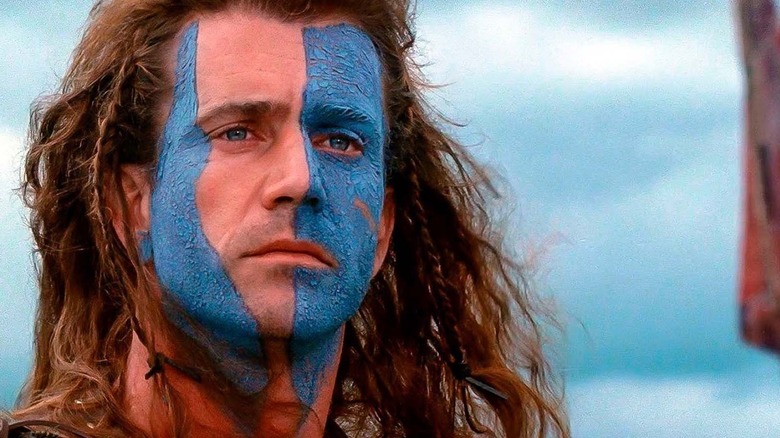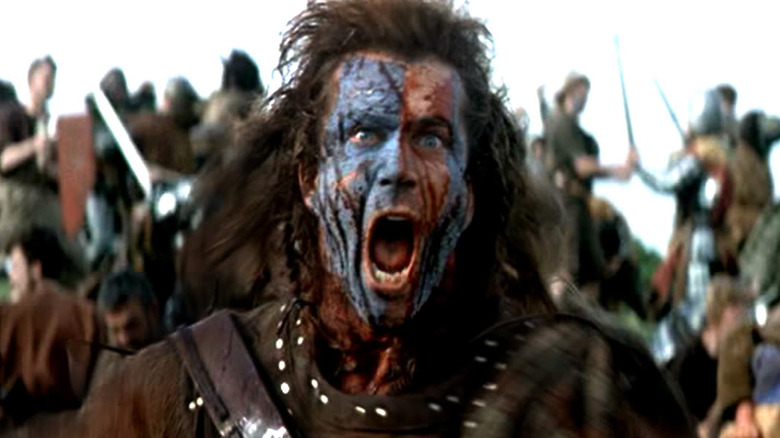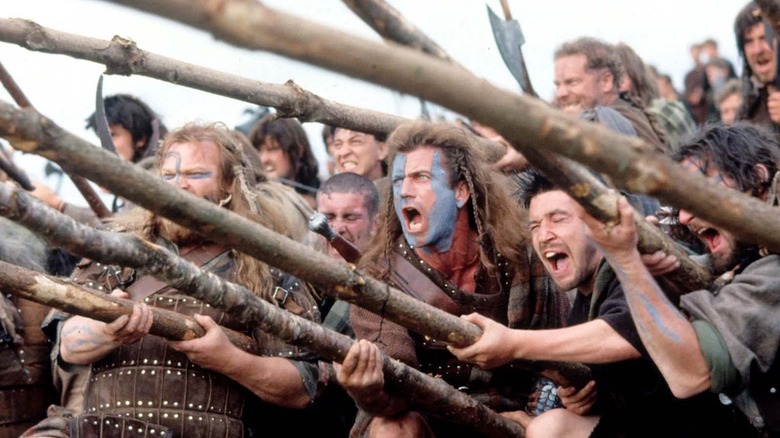Why Braveheart Is Considered One Of The Most Historically Inaccurate Films Ever
"They may take our lives, but they'll never take... our freedom!" Mel Gibson's 1995 historical epic, "Braveheart," sent chills down my spine when I first heard that classic rallying cry from William Wallace. It's a rousing scene – hundreds of Scots, under the leadership of William Wallace (Mel Gibson) preparing to take on the might of the English army at the Battle of Stirling Bridge. In reality, it was a key moment in the First War of Scottish Independence that saw Wallace become the Guardian of the Kingdom of Scotland. But in "Braveheart" it was completely historically inaccurate.
Yes, Wallace and his army did win at the Battle of Stirling Bridge, but the film neglected to mention his ally, Andrew Moray, who was mortally wounded there. Nor did the Scots armies make it as far south as York in the battle's aftermath. And those are just a couple of details that the film got wrong. The truth is, "Braveheart" is one of the most historically inaccurate films of all time.
I saw it in his face on the battlefield
After "Braveheart," the sight of Mel Gibson in blue face paint became an iconic image. A mere glimpse of his streaked face conjures up that rousing speech and the chanting Scots army. You can practically hear the bagpipes. But it turns out those painted faces and highland kilts are the stuff of pure fantasy. As Peter Traquair explained in his book Freedom's Sword that:
"[Wallace is a] farcical representation as a wild and hairy highlander painted with woad (1,000 years too late) running amok in a tartan kilt (500 years too early)."
In fact, the entire look of William Wallace and his rag-tag band of Scots is completely wrong. During this period, Scots didn't wear kilts. At all. Historian Sharon L. Krossa explains that even when Highlanders did start wearing kits, it wasn't "in the rather bizarre style depicted in the film."
"[It's like] a film about Colonial America showing the colonial men wearing 20th-century business suits, but with the jackets worn back-to-front instead of the right way around."
Now, I'm not the first to suggest that "Braveheart" isn't exactly an accurate portrayal of what really happened. Hilariously, Irish historian Seán Duffy pointed out that "the Battle of Stirling Bridge could have done with a bridge." But it all gets even worse when it comes to the film's ending.
'We all end up dead — it's just a question of how and why'
After waging a guerrilla war against the English, Wallace is eventually captured. Ultimately, "Braveheart" sees the Scottish legend betrayed by his own men, Lochlan and Mornay, who he kills in retaliation. He's soon captured in Edinburgh and then carted off to London to be brought before an English magistrate. Tried for high treason, he's condemned to a bloody and brutal end, to be hung, drawn, and quartered. In reality, it didn't quite happen like that.
Wallace was actually captured in Glasgow after spending several years in exile in France. Although he was betrayed, it was a Scottish knight, John de Menteith, who turned him over to English soldiers at Robroyston. And he wasn't exactly a man of the people, either. Historian A. E. Christa Canitz explains that Sir William Wallace was actually born into the Scottish gentry.
"[He] was a younger son of the Scottish gentry, usually accompanied by his own chaplain, well-educated, and eventually, having been appointed Guardian of the Kingdom of Scotland, engaged in diplomatic correspondence with the Hanseatic cities of Lübeck and Hamburg."
Not quite the Highland farmer we find in "Braveheart."
'Historians from England will say I am a liar'
After Wallace's death, "Braveheart" marches on to the fields of Bannockburn – the site of a bloody battle between English forces and Robert the Bruce (Angus Macfadyen). There, they are supposed to formally accept English rule. While Wallace himself has died, his spirit lives on.
Now the king of Scotland, Robert the Bruce rallies his men to stand against the English on the battlefield. Invoking Wallace's memory, he asks them to stand with him as they did with Wallace. And in an iconic moment, Hamish (Brendan Gleeson) throws Wallace's sword into the ground before the English army. The men begin to chant Wallace's name as Robert the Bruce leads them into a brutal and bloody conflict. It's a bloody, rousing and inspirational scene which sees the Scottish taking back their independence.
But again, that's not really how it all went down.
What happened at the real battle of Bannockburn?
It's no surprise that Hamish's dramatic sword toss is made up. But the entire scene is a complete fabrication.
"Braveheart" depicts the Battle of Bannockburn as a spontaneous uprising in defiance of English rule, but in reality, Robert the Bruce had been at war with the English for eight years at this point. Essentially, the Scottish uprising at Bannockburn wasn't unplanned, and it wasn't a tribute to William Wallace. And when it comes to the nickname "Braveheart," that wasn't Wallace either – it was actually the name used to refer to none other than Robert the Bruce. Mel Gibson explained to Daily Record:
"Some of the aspects of the battles are there, but they don't follow. Wallace did win the Battle of Stirling. He beat hell out of them, but just not the way I showed it. We boosted it up otherwise it would have been boring," he added. "We wanted to make something a little more cinematically compelling."
What we get is a highly fictionalized take on the Scottish legends. The film's final history lesson isn't exactly accurate either.
'We'll have what none of us has ever had before'
After a rousing speech, we see the Scots charge headfirst into battle against the English... and as the scene fades to Wallace's sword stuck defiantly in the ground, a triumphant voice tells us what happens next:
"In the year of our Lord 1314, patriots of Scotland, starving and outnumbered, charged the fields of Bannockburn. They fought like warrior poets. They fought like Scotsmen. And won their freedom."
It's an emotional ending with a stirring finale that would leave even the most hardened clansman teary-eyed. But while the Scots at Bannockburn may have fought like Scotsmen, they didn't exactly win their freedom. After the Battle of Bannockburn, Robert the Bruce continued his fight against the English monarchy for a further 14 years. The war for Scottish independence was waged through famine, civil war, and great political upheaval until 1328 when the kingdom of Scotland finally won its freedom.
Even then, freedom was short-lived, as Scottish nobles and their English allies refused to accept defeat, forcing the Scots into another war for independence just four years later. Probably not the ending that "Braveheart" director Mel Gibson had in mind.
What "Braveheart" delivered is a hodgepodge of history and make-believe, resulting in one of the most historically inaccurate historical epics of all time. It almost makes "Troy" look like a documentary. Still, it made for one hell of a movie, even if it isn't quite what really happened.
Every man dies, not every man gets his guts pulled out and lit on fire in front of him
The movie version of Wallace was granted a tragic, but dramatically satisfying death. Apprehended by the English, Wallace was sentenced to death by torture, followed by decapitation. Wallace is hanged (briefly), then drawn-and-quartered, a practice that involved tying an extremity to one of four horses, and then being pulled in four directions at once. Wallace is told that he can indeed ask for mercy, but that would require him to cow to the English. He, instead, yells "Freedom!" before his beheading.
In real life, Wallace was indeed apprehended for treason, but his execution was far messier. In the 2010 Cambridge thesis "The Law of Armed Conflict: International Humanitarian Law in War," Wallace was recorded as saying that he could not be a traitor to King Edward, as he was never an English subject. It was quite the zinger.
Historical documents show, though, that Wallace wasn't just executed, but tortured rather extensively. Prior to being hanged and drawn-and-quartered, Wallace was, like Hector in "The Iliad," stripped naked and dragged around town behind a chariot. Then came the hanging/drawing-and-quartering part of his torture. Then he was emasculated, his guts were pulled out of his stomach and lit on fire in front of him (!). Then he was beheaded. He may have yelled any number of things during this lengthy process, although "Freedom" is not recorded as among them.
Wallace's body was then cut up, and his limbs were hung on public display in various cities around Scotland as a warning. Wallace's severed leg makes a cameo in the 2018 film "The Outlaw King."
The Stone of Scone
The action in "Braveheart" is kicked off when Kind Edward I (Patrick McGoohan), in an attempt to reduce the Scottish population under his control, enacts the then-old law of jus primae noctis, which would allow English noblemen to forcibly impregnate Scottish women prior to their husbands. This act of legalized assault was intended to fill the country with minor English heirs, rather than full-blooded Scots.
In the movie, this was enough to cause Wallace to begin his uprising, although in real life, Edward I also took the more direct approach. In 1296, Edward I invaded Scotland and actually properly conquered it. To assert English dominance, Edward also absconded with the Scottish Stone of Scone, also known as the Stone of Destiny, a sacred relic that Scottish royalty used during coronation ceremonies. The stone is merely a rectangular slab, just over two feet long and a foot and a half wide. It only weighs about 152 kg (336 lbs). It has a cross carved into it.
Edward took the Stone and moved it to Westminster Abbey in a symbolic gesture of ending the Scottish monarchy as it stood. He put the stone under a specially made Kingly throne, implying that whoever was king of England was also King of Scotland. It's an epic burn of epic proportions.
Isabella
In "Braveheart," Wallace is moved to leading a revolution not just by jus primae noctis, but by the death of his beloved Murron MacClannough (Catherine McCormack). Over the course of the film, Wallace will find himself not just moving past his lost love, but falling for Edward's young bride, Princess Isabelle of France, played by Sophie Marceau.
Marceau was 28 at the time of production, which is quite a bit older than the real Isabella. The real Isabella was, in actuality, born in 1295, which would have made her only 10 at the time of William Wallace's execution. She was not yet married to Edward II, and she was most certainly not having an affair with Wallace.
Although she was married to Edward II at the age of 12 and was used as something of a political pawn, Isabella was more than a timid diplomat as depicted in "Braveheart." Indeed, at age 30, after having been ignored by her incompetent husband for years, she and her boyfriend, Roger Mortimer, raised an invading army in the Scottish lowlands. She married off her own eldest son to a count's daughter, shifting the line of succession away from Edward II and toward Mortimer.
Mortimer was more popular anyway, and he and Isabella were rulers of England for a short spell. That is until her own son rose up and deposed Mortimer. She retired to the country and died in 1358. Well done.







